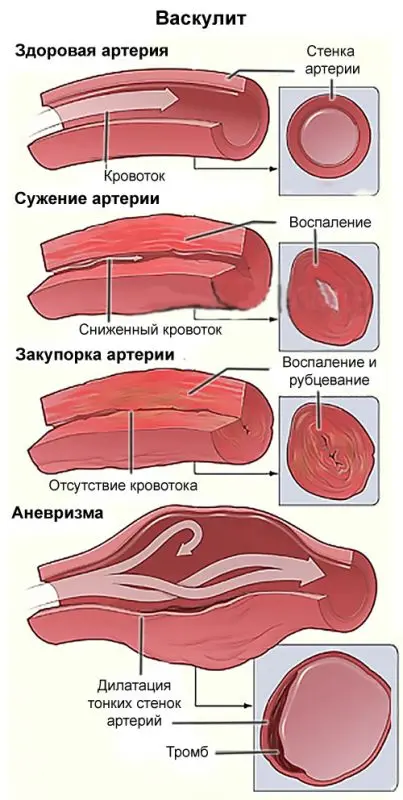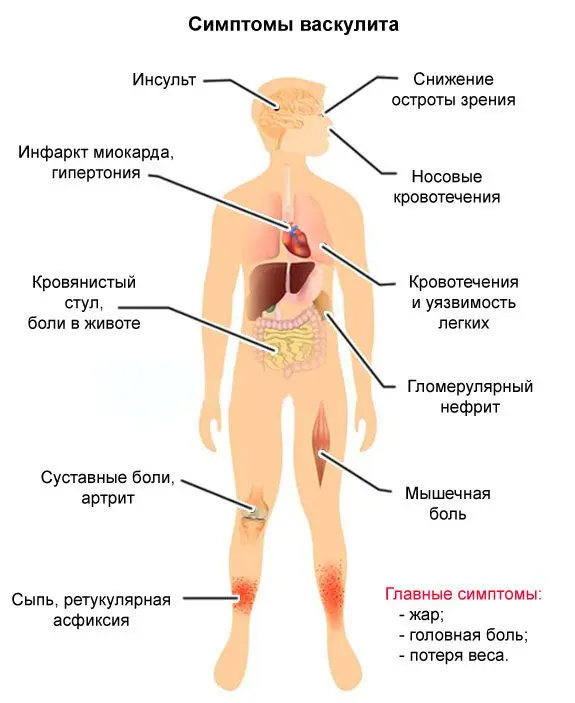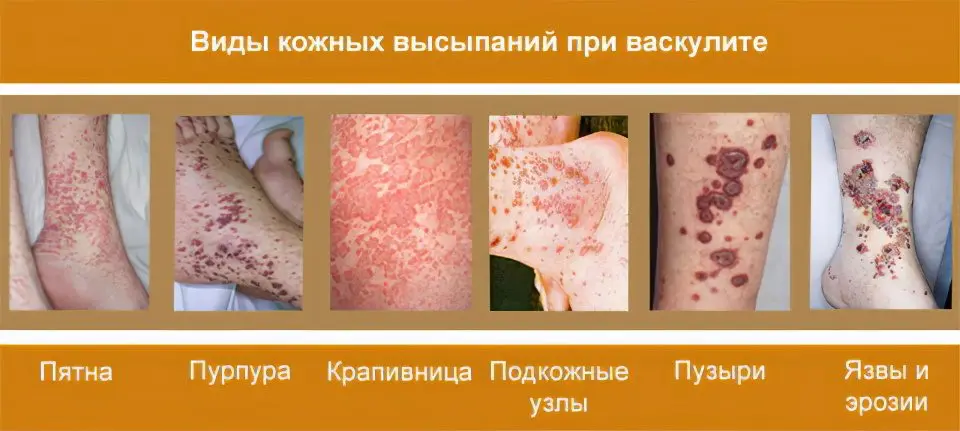Contents
What is vasculitis?
Vasculitis is a general name for a group of diseases characterized by inflammation and destruction of the walls of blood vessels. Usually, the disease affects several tissues or organs: the narrowing of the damaged vessels disrupts the blood supply to the organs and causes the death of the tissues supplied by them. The disease can occur in any organ.
If the patient does not receive treatment, then vasculitis will not stop progressing. This will lead to damage to various tissues and organs. A person can become disabled or even die.
Vasculitis is a systemic disease affecting the connective tissue. Rheumatologists are involved in the treatment of pathology. If necessary, the patient is referred to an infectious disease specialist and a dermatologist.

Both men and women suffer equally from vasculitis. Most often, the disease is diagnosed in children and the elderly. Pathology is on the rise. Every year the number of people with vasculitis increases. Scientists attribute this to the uncontrolled and unjustified intake of immunomodulatory drugs, as well as to the deterioration of the environmental situation in the world as a whole.
Vasculitis classification

Vasculitis has a large number of subspecies and classifications, they differ in severity, localization and etiology. Some vasculitis affects only the skin, without causing serious harm to other organs, while others can cause irreparable damage to vital organs and, if not properly treated, lead to death.
Depending on the causes of vasculitis, they are divided into two types: primary and secondary:
Primary vasculitis occurs independently and is not accompanied by other diseases.
Secondary vasculitis are concomitant diseases of other pathologies. A similar reaction can occur to tuberculosis, hepatitis, syphilis, etc. Sometimes vasculitis is the result of a systemic lesion of the body (lupus erythematosus, collagenoses, reactive arthritis). Oncopathology, parasitic invasions, sarcoidosis, intoxication of the body can provoke vasculitis.
Depending on the severity of the course of the disease, vasculitis can be:
Easy. The general well-being of a person is not disturbed. The only manifestation of the disease is a mild skin rash.
Medium. In this case, the patient has multiple rashes on the body, blood appears in the urine, the joints hurt a lot, and appetite disappears. General well-being is disturbed.
Heavy. If the disease has a severe course, then the rashes will be plentiful, the joints and internal organs undergo pathological changes. The patient is hospitalized with internal bleeding (pulmonary or intestinal). Renal failure is often diagnosed. The patient feels very bad.
Forms of vasculitis:
Capillary. In this form of the disease, inflammation of small blood vessels is observed.
Arteriolitis. The arterioles are inflamed.
Arteritis. Immune cells attack the arteries.
Phlebitis. In this case, the veins become inflamed.

Types of vasculitis, depending on the location of the pathological process:
Systemic necrotizing vasculitis. Inflammation spreads to several parts of the body, including periarteritis nodosa, micropolyangiitis, Churg-Strauss syndrome, mixed vasculitis, Wegener’s granulomatosis, giant cell arteritis, nonspecific aortoarteritis, hemorrhagic vasculitis, allergic skin vasculitis, Kawasaki syndrome, Behcet’s disease.
Vasculitis of individual organs. Vessels that feed a certain organ are involved in the process of inflammation. If the brain suffers, then the patient develops primary CNS angiitis. When the vessels that feed the skin are affected, the patient is diagnosed with cutaneous leukocyte clastic angiitis, periarteritis nodosa. If the joints suffer, then they talk about hemorrhagic vasculitis. When the heart is damaged, the patient develops isolated aortitis.
Symptoms of vasculitis
Depending on the localization of vasculitis and concomitant disease, its symptomatic picture also varies. When vasculitis affects the skin, a rash appears. In case of damage to the nerves, the sensitivity of a person is disturbed – from hypersensitivity to its complete loss. A disruption in the blood supply to the brain causes a heart attack (heart stroke). Renal failure may develop due to renal vasculitis. Common symptoms of vasculitis may be lack of appetite, fatigue, weakness, fever, pallor.
Nodular vasculitis is characterized by muscle pain, weight loss, abdominal pain, nausea and vomiting, mental disorders. Wegener’s granulomatosis affects the paranasal sinuses: in patients, purulent and bloody discharge comes out of the nose, the nasal mucosa becomes covered with sores; there may be a cough (sometimes with blood), shortness of breath, chest pain, and kidney failure may develop. Giant cell arteritis is manifested by fever, weakness, weight loss, severe headaches and swelling in the temples. Symptoms of nonspecific aortoarteritis are pain and weakness in the arms and legs, blurred vision, fainting. Behçet’s syndrome is accompanied by recurring stomatitis, ulcers on the genitals, inflammation of the eyes.

Rash
Rashes with vasculitis may vary, but there are signs that make it possible to suspect this particular pathology:
The rash appears after an infectious disease.
Rashes are characterized by symmetry.
The first elements of the rash appear on the legs. The shins are affected first.
The rash looks like bruising. The skin in these places swells, tissue necrosis may begin.
The elements of the rash are varied. Over time, they do not change their size, shape and color.
A rash with vasculitis can have the following character:
Rash like spots. The spots may be pink or reddish. The rash is flat, the spots do not rise above the surface of the dermis. Such spots appear due to the fact that blood rushes to the vessels in order to stop the inflammatory reaction.
Hemorrhagic purpura. Such a rash appears when the integrity of the vascular wall is damaged. The rash looks like purple spots. Its borders are not even, the elements in diameter can reach 3-10 mm. After a while, the elements of the rash become blue, and then turn yellow. If you press on the rashes, they do not disappear.
Hives. This rash appears due to an allergic reaction of the body. The patient complains of burning and itching in the affected area. The rash itself looks like reddish-pink vesicles of irregular shape.
Subcutaneous nodules. Such elements of the rash are accompanied by uncontrolled growth of connective tissue. Nodules can rise significantly above the surface of the dermis, or they can be flat. The size of the nodules is 10-20 mm. If you press on the element of the rash, then the person will feel pain. Since these elements of the rash do not receive normal nutrition, they undergo necrosis. It starts from the central part of the nodule, gradually spreading to the surrounding dermis.
Bubbles The walls of blood vessels with vasculitis lose their normal density. This leads to the fact that in some parts of the collaterals, plasma begins to sweat through their wall. It accumulates under the skin, which leads to the appearance of blisters on it. They will be filled with transparent content. Sometimes formed elements of blood appear through the vessels.
Ulcers and erosions. Subcutaneous nodes disintegrate over time. Erosions and ulcers form in their place. If an infection gets into them, which happens very often, then these areas begin to rot.

Intoxication of the body
Violations in the circulatory system lead to the fact that a large amount of toxins accumulate in the body. This causes the failure of metabolic processes.
As a result, a person suffers from symptoms such as:
Weakness and rapid physical fatigue.
Lack of desire to eat, weight loss. A person can lose up to 1 kg per month.
Increased sleepiness.
Increase in body temperature. If the disease has a mild course, then the mark on the thermometer does not exceed subfebrile indicators. In severe vasculitis, it reaches feverish values.
Neurological symptoms
Violation of blood circulation affects the functioning of the nervous system.
This leads to the following symptoms:
Emotional instability.
Convulsive attacks.
Muscle atony, partial paralysis of the limbs.
Intracerebral hemorrhage, which can lead to hemorrhagic stroke.
Damage to the organs of vision
Vasculitis can affect one or both eyes. The disease leads to visual impairment, up to the development of blindness. The mucous membrane of the eye becomes red and swollen. Movement of the eyeballs provokes painful sensations. Exophthalmos may develop.
Respiratory damage
Problems with blood vessels lead to inflammation of the organs of the respiratory system.
This may present with symptoms such as:
Protracted rhinitis.
Prolonged sinusitis and sinusitis.
Destruction of the bony walls of the maxillary sinuses and nasal septum.
Bronchitis that lasts a long time and is difficult to treat.
Bronchial asthma.
Inflammation of the pleura of the lungs.
Pneumonia.
bronchiectasis.
If there is a violation of the integrity of the vessels, then the patient develops bleeding. Their strength may vary.
Kidney damage
Vasculitis can lead to various pathologies of the kidneys. At the same time, a person complains of pain in the lower back, he is haunted by edema, the amount of urine excreted decreases. There may be an increase in body temperature and the appearance of blood in the urine.
The stronger the malnutrition of the kidneys, the more massive the damage to their tissues. Ultimately, the disease leads to the development of kidney failure.
Diseases of the joints
Vasculitis can lead to damage to the articular bag. Pathological exudate begins to accumulate in it, edema and inflammation develop. The knees are the first to suffer.
Symptoms of joint damage:
Swelling in the area of the kneecap.
Rash on legs.
Severe pain in the knees.
Deterioration of joint performance.
Then the inflammatory process from the knees spreads to the adjacent joints. Coping with developing changes is difficult, often they are irreversible.
Damage to the digestive system
With vasculitis, the vessels of the mesentery and intestines can suffer. This contributes to the development of internal bleeding.
Violation symptoms:
Severe abdominal pain that gets worse 30 minutes after eating.
Nausea and vomiting.
Diarrhea with impurities of blood.
As the disease progresses, the likelihood of intestinal atrophy with a rupture of its walls increases. The larger the lesion, the higher the likelihood of peritonitis.
Causes of vasculitis
The etiology of vasculitis is not well understood. Often this pathology is associated with a variety of viral infections and immune diseases. Often, vasculitis causes an allergic reaction to certain medications.
Vasculitis can develop as a complication of past infections. In this case, the body has an abnormal reaction of the immune system to the infection, as a result of which the blood vessels are destroyed.
The precursors of vasculitis can also be chronic or chronic autoimmune diseases (glomerulonephritis, reactive arthritis, inflammation of the thyroid gland, systemic lupus erythematosus, Schwartz-Jampel syndrome, etc.)
Video: M.N. Valivach from the Pavlodar Regional Diagnostic Center will tell you about vasculitis:









